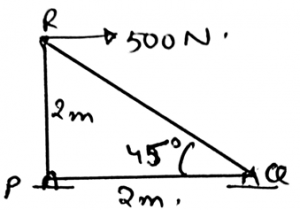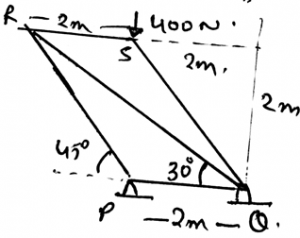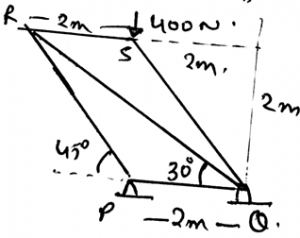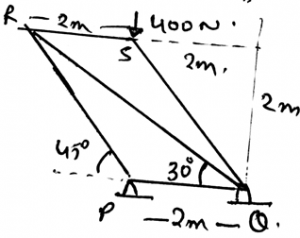This set of Engineering Mechanics Multiple Choice Questions & Answers (MCQs) focuses on “Simple Trusses – 1”
1. __________ is a structure made of slender members which are joined together at their end points.
a) Truss
b) Beam
c) Pillar
d) Support
View Answer
Explanation: The truss is a structure made of slender members which are joined together at their end points. They can be of wooden or steel. But most probably they are made from stainless steel. As they need to support the loadings in various climates.
2. _________ trusses lie on a plane.
a) Planar
b) 2D
c) Linear
d) 3D
View Answer
Explanation: The planar trusses lie on a plane. Like for e.g. the trusses in the bridges. These trusses are the main supports of the bridge. They are extended straight vertical and are strong enough to resist various changes in the weather.
3. In a roof supporting truss the load is transmitted when ________
a) First to the truss then the joints through purlins
b) First to the purlins then the joints through trusses
c) First to the truss then the purlins through joints
d) First to the joints then the trusses through purlins
View Answer
Explanation: The roof load is transmitted to the truss first. It is then transmitted to the joints. This transmission of the force or the load from trusses to the joints is achieved by the purlins. Thus the distribution of the load.
4. As the loading is acting in the two dimensions, that is in a single plane. Thus the calculations involved in the trusses are in 2D.
a) True
b) False
View Answer
Explanation: The loading is acting in a plane. Thus the calculations are done in 2D only. As the equations for 3D are different. Although the use of vectors can make our task easy but still 2D calculations are done for the trusses, as they are acting in a same plane.
5. In case of bridge the load is transferred when __________
a) Stringers > floor beams > joints
b) Floor beams > stringers > joints
c) Joints > floor beams > stringers
d) Stringers > joints > floor beams
View Answer
Explanation: The bridge load is transmitted to the stringers first. It is then transmitted to the floor beams. The load from beams is then transmitted to the joints. Thus the transmission of the load of the bridge.
6. As the loading in bridge different from the simple trusses the calculations involved in the bridges are all 2D calculations.
a) True
b) False
View Answer
Explanation: The loading in the bridge is acting in a plane. Thus the calculations are done in 2D only. As the equations for 3D are different. Although the use of vectors can make our task easy but still 2D calculations are done for the trusses, as they are acting in the same plane. But the thing is that the loading in bridge and trusses are same.
7. When the bridges are extended over long routes or distance then _________
a) A rocker or a roller is used at the joints
b) They are not extended to such a long distance
c) The bridges are painted
d) The roads are made narrow
View Answer
Explanation: When the bridges are extended over long routes or distance then a rocker or a roller is used at the joints. This allows the bridge joints to move around. That is when the temperature is raised. The elongations and the contractions of the joints part are not much affected if the rollers and rockers are used.
8. Find the force in the member RP of the frame shown below.

a) 707.1N
b) 500N
c) 505N
d) 784N
View Answer
Explanation: The direction of the unknown is not known to us. To know the direction of the unknown force we take assumption of it. That is we assume that the particular direction might be the direction of the force and then we do the calculations accordingly. And then we apply the equilibrium equations to the joints.
9. To design the trusses which of the following rules is followed?
a) All the loads are applied by the use of cables
b) The loads are applied at the joints
c) All the loads are not applied at the joints
d) The loads are not applied at all to the joints
View Answer
Explanation: The set of rules which are used to design the trusses are having various rules. To them, one is that the loads are applied at the joints. This is done with the neglecting of the weight of the trusses section.
10. The rules which are used to design the trusses are having various rules. Of them one is that the smooth pins are not used to join the members.
a) Statement is correct
b) Statement is incorrect
c) Statement is incorrect because there are no rules
d) Statement is incorrect as the rolling pins are used
View Answer
Explanation: The set of rules used to design the trusses are having various rules. Of them one is that the smooth pins are used to join the members. The joint are generally formed by welding the materials at the ends of the trusses. Which gives strength to the design.
11. Find the force in the member RQ of the frame shown below.
a) 566N
b) 400N
c) 773N
d) 1090N
View Answer
Explanation: The direction of the unknown is not known to us. To know the direction of the unknown force we take assumption of it. That is we assume that the particular direction might be the direction of the force and then we do the calculations accordingly. And then we apply the equilibrium equations to the joints.
12. Find the force in the member QS of the frame shown below.
a) 566N
b) 400N
c) 773N
d) 1090N
View Answer
Explanation: The direction of the unknown is not known to us. To know the direction of the unknown force we take assumption of it. That is we assume that the particular direction might be the direction of the force and then we do the calculations accordingly. And then we apply the equilibrium equations to the joints.
13. A _________ truss is in triangular section.
a) Equilateral
b) Simple
c) Complex
d) Lateral
View Answer
Explanation: A simple truss in the shape of a triangle. It is the equilateral triangle. That is the angle between the legs are 60. This means the load is divided according and are equal in all the legs of the truss. Hence the simple truss.
14. Find the force in the member PQ of the frame shown below.
a) 566N
b) 546N
c) 773N
d) 1090N
View Answer
Explanation: The direction of the unknown is not known to us. To know the direction of the unknown force we take assumption of it. That is we assume that the particular direction might be the direction of the force and then we do the calculations accordingly. And then we apply the equilibrium equations to the joints.
15. Which of the following is correct?
a) To know the direction of the unknown force we take the assumption of it
b) The direction of the unknown force is known to us already
c) The direction of the unknown can’t be determined
d) The direction of the unknown is of no use, it is not founded
View Answer
Explanation: The direction of the unknown is not known to us. To know the direction of the unknown force we take the assumption of it. That is we assume that the particular direction might be the direction of the force and then we do the calculations accordingly.
Sanfoundry Global Education & Learning Series – Engineering Mechanics.
To practice all areas of Engineering Mechanics, here is complete set of 1000+ Multiple Choice Questions and Answers.
If you find a mistake in question / option / answer, kindly take a screenshot and email to [email protected]



